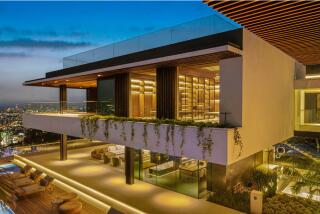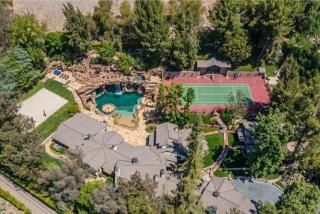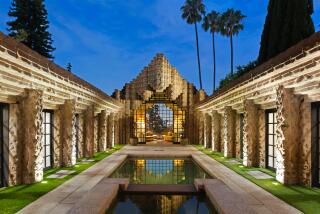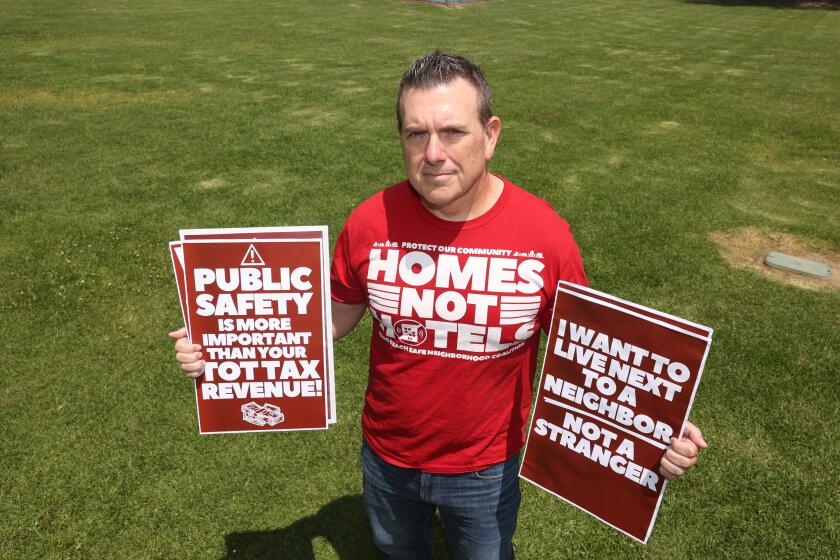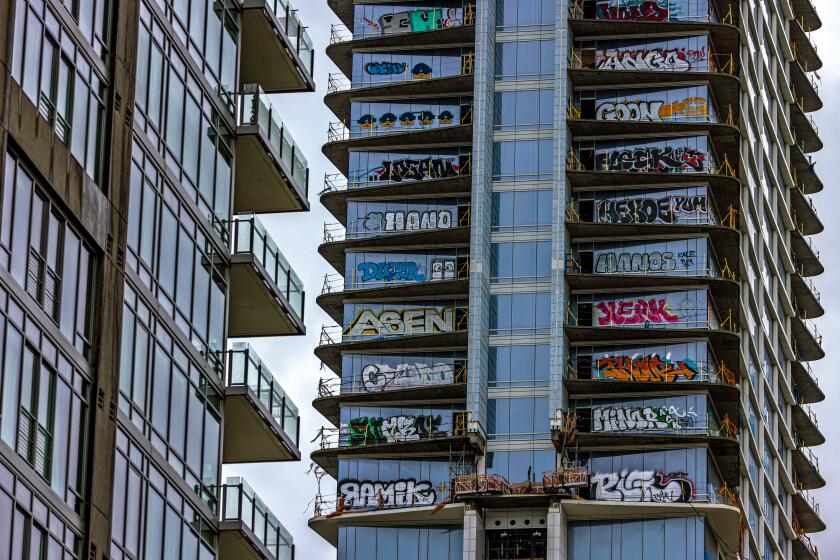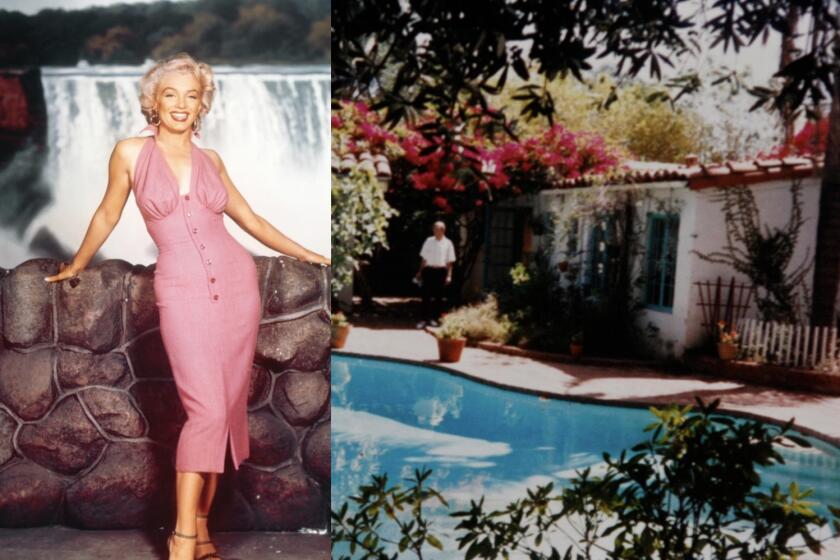Basements Are Back : If you can’t go up or out, go down.
In the four-bedroom house they were building, Kathy and Howard Gillman wanted a gym, sauna, wet bar, laundry, maid’s quarters, a billiard room and a darkroom. But these wish-list features would have taken up their whole back yard.
Instead, they built a basement.
“I’m from New York, so I thought of a basement when it came to needing more space,” he said. “We ended up with a good-sized pool outside, a nice back yard and a lot of living space in the basement.”
The basement is back, bigger and better than ever, in Southern California.
The trend started on the Westside of Los Angeles. As land prices soared and cities there enacted building codes to limit how much of a lot could be covered by a house, more and more homeowners opted to go down instead of out.
Since then, the movement to build basements, though still mainly confined to high-end housing, has grown.
“Economics is the driving force,” said Dave Shaw, a Redondo Beach engineer and general contractor who has built about 30 basements along the Strand.
“When property values went up, people wanted to build the maximum livable area possible, but on most lots you can only go so high, and you can only build over so much of the pad. If you go below grade, you can get a whole other floor.”
Some people want basements for such luxuries as screening rooms, indoor swimming pools, ballrooms, discos, hair salons, racquetball and handball courts. Other folks just want a spare room for a hobby or a place for the kids to play.
The decision to dig down for such rooms has even spread to the desert.
“Traditionally, nobody had a basement in the desert,” said Rancho Mirage architect Steve Chase, “but now I’m doing three projects with basements, and the biggest reason here is that the cost to go down hasn’t changed as much as the cost of land.”
At Bel-Air Crest, a Westside Los Angeles development of custom and production homes, the basement is a standard option in three models.
“We show them as storage in our plans, but they are a good size--400 to 500 square feet, and some have been converted into offices or studies,” said Suzy Hillshafer, director of residential and commercial sales for the developer, Goldrich & Kest.
The homes are priced from about $1 million each, a good $100,000 more than models without basements.
Basements aren’t cheap. It’s easier to lay down a slab than to excavate, and excavation brings extra costs. So, although some architects and builders say that basements can be built--as they are on the East Coast--in houses of every price range, basements in Southern California are being built so far primarily in expensive homes.
“Basements aren’t usually something you would include in a budget project,” said Hermosa Beach architect Jerry Compton. “About half the expense is doing the excavation and carting the dirt away. Then there’s the cost of where to drop the dirt. Add to that the cost of footings and shoring.”
Shaw, the Redondo Beach engineer, said it costs $7 to $10 a square foot to build a foundation at grade level, “but if you go down with the foundation, you’re probably talking of doubling that when you include the concrete, masonry and waterproofing.”
The price doubles again when building a basement under an existing house, said Erik Phelan, a Redondo Beach engineer/contractor/developer who builds about three basements a month.
There are other considerations, however, such as getting more yard and a smaller roof line.
Architect Gus Duffy designed his first basement in the Beverly Hills flats about five years ago in response to a neighborhood outcry about losing open space. Since then, he has designed many more homes with basements.
“If you take 15,000 square feet and distribute it in two stories, you get 7,500 square feet per floor, but if you take three stories, you get 5,000 square feet per floor and the other 2,500 square feet is trees and yard,” he said.
“Basements aren’t particularly expensive to build as compared with regular, two-story houses, because the roof on a house with a basement is a third smaller, and the level of finish isn’t usually the same as rooms on the upper floors.”
Santa Monica architect Ted Karonis, who has designed at least 15 basements, said, “Maybe 25% to 30% of the cost factor of a house is in the foundation, and it only takes another $2 to $3 a square foot to excavate, so it’s not that major of an expense.”
It’s even less when the basement is smaller than the footprint of a house, as many so-called “California basements” are, or if the house is built on a slope, reducing the amount of excavation that is necessary, he noted.
Hillside basements also have easier access to natural light, but architects are bringing daylight into basements by using such design tricks as raising a house by a few feet so part of its basement is above grade.
Dr. Sy Morrow, who is building new houses with basements in Santa Monica with his son, Paul, uses light wells, which function like skylights, and underground courtyards to bring in light.
The “basement court,” as this type of courtyard is called, created a problem in one home, another builder recalled.
A grassy area in the courtyard was designed without an outside stairway leading up to the ground level. So the gardener had to carry a lawn mower through the house to get to the lawn.
Paul Zahler, who has built about 50 basements on the Westside in the past few years, used another design trick to bring in light: He constructed a basement with a window looking into an outdoor swimming pool.
“Looking through that window is like looking into an aquarium,” he said.
Corona del Mar architect John McGinnes uses glass block and pavers out of glass to bring in the light, and Westside architect John Siebel designed a basement with an indoor swimming pool separated from a recreation room by glass doors, for the same reason.
With good lighting, outdoor access and adequate ventilation, basements can be used for bedrooms and other habitable purposes, though zoning and building codes vary from one community to another and should be checked for allowable uses.
“Basements are being used for much more than they were in the past,” said Dietmar Kruger of Ardsley Construction in West Los Angeles.
Most houses built in California during the 1920s and ‘30s had basements for gravity heaters, but after that, few new homes had basements. Starting in the ‘40s, houses were built on concrete slabs with forced-air heating units on the ground floor. Later, many heaters were installed in attics.
Basements of the past were basically used for utilities and water pipes, but elaborate use was made of parts of the basements in the old estates, said Jeff Hyland, a Beverly Hills real estate broker who co-wrote “The Estates of Beverly Hills.”
Silent screen star Harold Lloyd built his Beverly Hills basement with a big closet in it for a 24-hour-a-day PBX telephone operator.
Lloyd’s basement also had a long hallway leading to a smoking room, which had a fireplace. The chimney for this fireplace had four lion’s heads on it. “When Tom Mix, Charlie Chaplin and other friends would see smoke coming from the lions’ mouths, they’d know it was party time,” Hyland said.
“Driving Miss Daisy” co-producer Jerry Perenchio’s “Kirkeby Estate,” which was used regularly in the “Beverly Hillbillies” ’60s sitcom, was also built during Hollywood’s Golden Era with a ballroom in its basement.
And Hyland has a listing on a $35-million house, built in the ‘20s for cowboy star Fred Thompson and screenwriter Frances Marion, that has a 60-seat theater below grade level.
Many old basements are being given new uses. A Bel-Air estate, now owned by the department-store Ohrbach family, was built for actress Barbara Stanwyck and actor Robert Taylor in the ‘40s with a bomb shelter in its basement.
“It has a shower to wash off the radiation, two bunk beds and a separate water supply,” said Cecelia Waeschle, who has the $8.25-million listing with Rodeo Realty.
It still has the bomb shelter, but it was redesigned so it now also has wine and fur storage.
Dr. Taro Yokoyama and his wife, Rita, built their new Beverly Hills house over an old basement in a house once owned by actress Jane Wyman. They turned a grungy hole for a furnace into a sophisticated computer center, for running the house, and a wine cellar behind an etched glass door.
Ron Wilson, who designed a basement with a gym in it for Cher’s 11,000-square-foot home in Aspen, turned a furnace room in an old Bel-Air house into a tri-level area with a gym, bedrooms, playroom, steam room, baths and laundry in it. The area increased the livable size of the house from 10,000 to 15,000 square feet, he said.
New technologies have made it possible to overcome problems that prevented old basements from being used so extensively, and now even new threats, like radon gas seeping up from the ground, can be remedied.
Ed Nash, a Manhattan Beach developer with a home on the Strand, built his 2,000-square-foot basement at the water table but thanks to an advanced sump pump and well, he’s experienced no flooding.
Difficulties in excavating in sand and clay can be overcome, others say, and earthquakes are less of a concern with a basement, because a basement tends to anchor a house. “It’s like driving a stake into the ground. It’s harder to move the house than if it was just sitting on the soil,” Karonis explained.
“I think many people here just don’t know the value of a basement.” He’s so bullish on basements, in fact, that he quips, “Buying a house without a basement is like buying a car without wheels.”
Speaking of wheels, many basements in Southern California are being built to house cars.
Perenchio and “All in the Family” writer/producer Norman Lear took their cues from subterranean parking at office buildings and multiunit residential complexes when they built underground motor courts, each for 30 cars, at their homes.
Lear built his garage under a tennis court at his Mandeville Canyon home. Perenchio built his next to a wine cellar under some gardens at his Bel-Air estate.
“A lot of people at Mulholland Estates have 10-car garages,” said Joe Babajian of Fred Sands Estates, who handles sales for the development. “They put in wine cellars, media centers and playrooms next to their underground parking.”
Ken Chang, Mulholland Estates developer, says he knows of a house there that has a basement with a wine cellar and a full machine shop “with a collection of prized machine tools that are rare and impossible to find. The shop also has some well tooled, metal-working machinery in it.”
Wine cellars are popular in basements, “because the earth doesn’t transfer heat and cold changes quickly,” said Culver City architect Richard Landry.
That’s why Guess? co-owner Maurice Marciano will keep his art collection in a 5,000-square-foot basement that is part of a 20,000-square-foot Westside house that Landry designed. “The collection requires temperature control,” Landry explained.
Marciano’s basement will also have a wine room, playroom, two maids’ rooms with a sitting room and kitchenette; a four-car garage, mechanical equipment for the house, a laundry and a 35-seat theater.
Theaters, media centers or specialized video rooms are popular basement features at Beverly Park, overlooking Beverly Hills, and other areas of the Westside, where many residents work in entertainment.
Robert Rubenstein of Malibu Realty has two $6-million-plus listings on Broad Beach. Both have 20-seat theaters in them that are below grade level.
North Hollywood architect Ron Firestone and his son, Chris, designed a 5,000-square-foot basement with a 42-seat theater for a Holmby Hills house that is under construction. The owner is a pianist and wants to give concerts there.
Westside architect Bill Hablinski, who designed a Mulholland Estates house for actor Fred Dryer with a wine cellar in it, didn’t put a theater in a basement he just designed for a 28,000-square-foot home planned for a 22-acre site in the Beverly Hills Post Office area.
But Hablinski describes it as “the mother of all basements,” anyway.
It will be 8,000 square feet in size and will have room for a car collection, wine cellar and two-bedroom maid’s apartment, which will open onto a sunken garden.
Westside/Orange County architect Robert Earl put a shooting gallery and a museum with a vault in the basement of a Newport Beach home and designed a Mulholland Estates home for jockey Chris McCarron, which has a basement with a wine cellar, gym and small theater.
“The basement is more than a trend,” Earl said. “It’s becoming a way of life in estate type living.”
But architect Landry, who just completed plans for a 2,500-square-foot home on a 25-foot-wide lot in Santa Monica, contends that basements needn’t be just for the wealthy.
“The same principles could be applied to everybody, as they are in the Eastern states and Canada, where I’m from,” he said.
Kruger, of Ardsley Construction, remembers the basements in Germany, his native country, and the East Coast, where he lived when he first came to the United States.
“Everyplace else, the basement is a necessity,” he said, “and it will become a necessity in Southern California because of the cost of land.”
